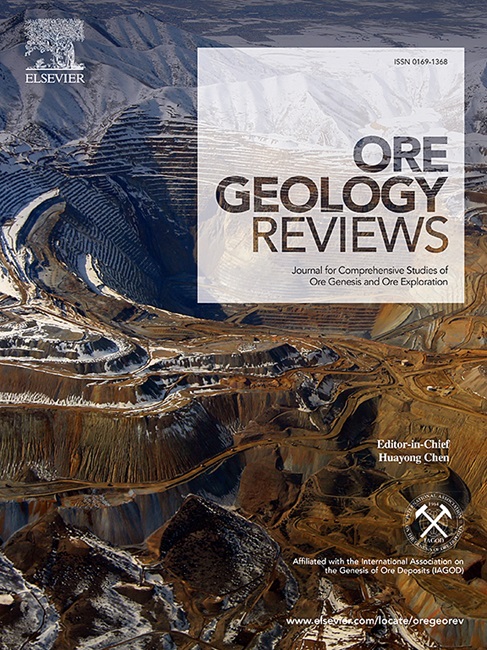中国东部龙桥矽卡岩铁矿床中钴的分布和富集过程
IF 3.6
2区 地球科学
Q1 GEOLOGY
引用次数: 0
摘要
龙桥是中国东部的一个富钴矽卡岩铁矿床。作为此类矿床的典型代表,它为研究此类矿床中钴的发生、分布和控制因素提供了机会。龙桥矿床中的含钴矿石可分为两种类型:含钴透辉石-磁铁矿(Co-Di-Mag)和含钴辉绿岩-磁铁矿(Co-Phl-Mag)。对这两种矿石进行了系统的全岩地球化学分析、自动矿物分析(TESCAN 综合矿物分析仪,TIMA)和 LA-ICP-MS 微量元素分析。在 Co-Di-Mag 中发现了三种独立的钴矿物(钴矿、釉钴矿和卡罗莱矿);在 Co-Phl-Mag 中没有发现独立的钴矿物。TIMA 和 LA-ICP-MS 分析表明,Co-Phl-Mag 中的钴主要赋存于黄铁矿中,因此黄铁矿的含量对总体钴含量起着决定性作用。在透辉石-磁铁矿阶段(第一阶段)和辉绿岩-磁铁矿阶段(第二阶段),钴主要赋存于磁铁矿中,随着体系的演化,钴的含量从 80ppm 逐渐下降到 30ppm。在硫化物阶段,侵入体附近沉积了少量黄铁矿,钴出现在黄铁矿晶格中,也形成了许多独立的钴矿物。龙桥矿床的钴主要赋存于黄铁矿中,有利于选矿和回收。类似的矽卡岩铁矿床在中国东部分布广泛,这些矿床中的钴具有回收潜力。本文章由计算机程序翻译,如有差异,请以英文原文为准。

Distribution and enrichment processes of cobalt in the Longqiao iron skarn deposit in Eastern China
Longqiao is a cobalt-rich skarn iron deposit in Eastern China. As a typical representative of its type, it provides an opportunity to study the occurrence, distribution, and factors controlling cobalt in these deposits. Cobalt-bearing ores in Longqiao deposit can be classified into two types: cobalt-bearing diopside-magnetite ore (Co-Di-Mag) and cobalt-bearing phlogopite-magnetite ore (Co-Phl-Mag). Systematic whole-rock geochemical analysis, automated mineral analysis (TESCAN Integrated Mineral Analyzer, TIMA), and LA-ICP-MS trace element analysis were conducted on the two ore types. Three independent cobalt minerals(cobaltite, glaucodot, and carrollite)were found in Co-Di-Mag; no independent cobalt minerals were found in Co-Phl-Mag. TIMA and LA-ICP-MS analyses showed that cobalt in Co-Phl-Mag is mainly hosted in pyrite, so the pyrite content has a decisive role in the overall cobalt content. Cobalt in Co-Di-Mag is controlled by the content of magnetite, pyrite, and cobalt minerals.
In both the diopside-magnetite stage (Stage I) and phlogopite-magnetite stage (Stage II), the cobalt mainly occurs in magnetite, and its content gradually decreases from 80 to 30 ppm as the system evolved. During the sulfide stage, minor pyrite deposited near the intrusion, and cobalt occurs in the pyrite lattice and also forms numerous independent cobalt minerals. Pyrite is abundant in the distal part of the ore-body, where all cobalt occurs in pyrite, and independent cobalt minerals are absent.
Cobalt mainly occurs in pyrite in Longqiao deposit, which is favorable for beneficiation and recovery. Similar skarn iron deposits are widespread in eastern China, and the cobalt in these deposits has potential for recovery.
求助全文
通过发布文献求助,成功后即可免费获取论文全文。
去求助
来源期刊

Ore Geology Reviews
地学-地质学
CiteScore
6.50
自引率
27.30%
发文量
546
审稿时长
22.9 weeks
期刊介绍:
Ore Geology Reviews aims to familiarize all earth scientists with recent advances in a number of interconnected disciplines related to the study of, and search for, ore deposits. The reviews range from brief to longer contributions, but the journal preferentially publishes manuscripts that fill the niche between the commonly shorter journal articles and the comprehensive book coverages, and thus has a special appeal to many authors and readers.
 求助内容:
求助内容: 应助结果提醒方式:
应助结果提醒方式:


